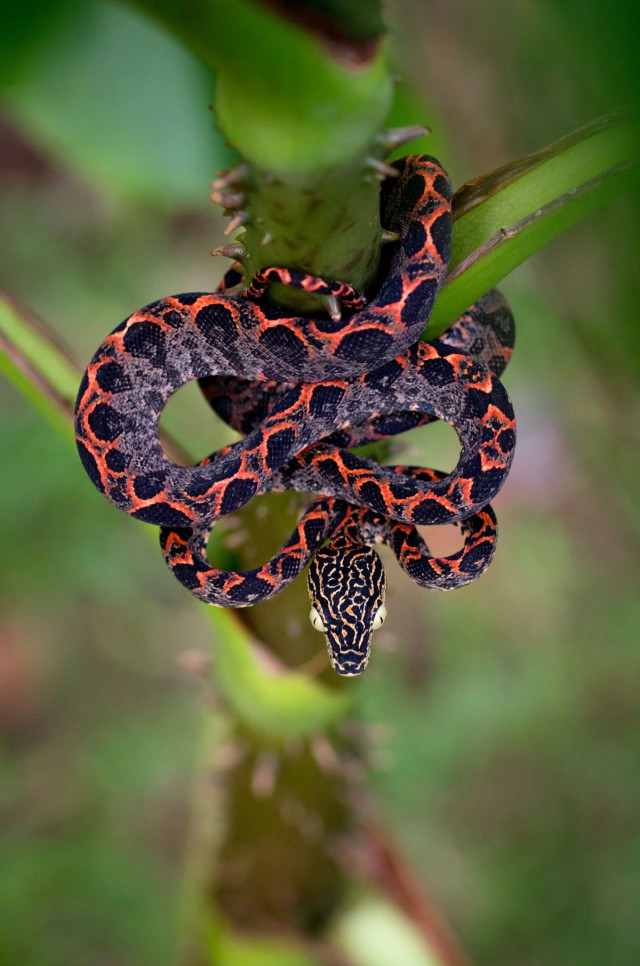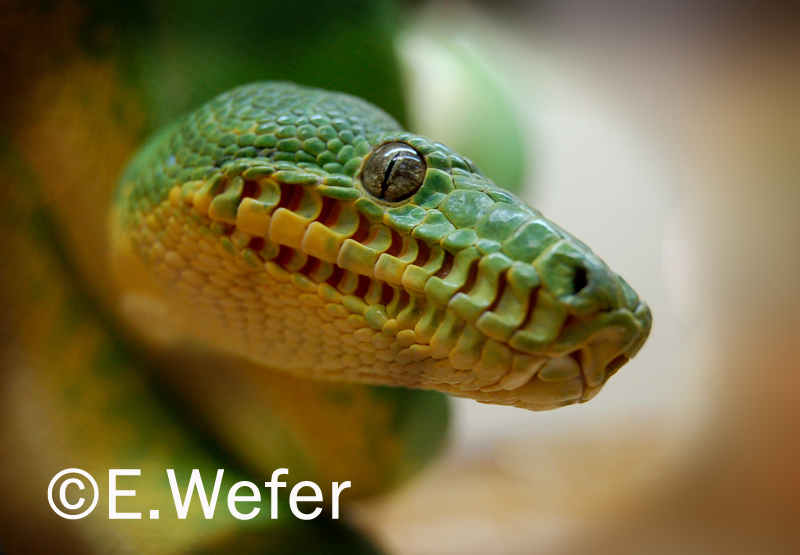Boidea (58 species) is a superfamilly of popular boas. Inside this taxa we don't find anymore calabar ground python. Long time ago he was classified as python but actually he isn't python nor boa and form another his own superfamilly Calabariidea (with one species). However Calabaria reinhardi (calabar ground boa or calabaria) is still in Erycinae family (old world sand boas) which ones he is isn't close relatives. I need to mention that this still will change because Sanziniinae are paraphiletictaxa (not all relatives are in this group), One of the biggest differences between calabria and boas are in the methods of reproduction. Boas are viviparous and calabarias are oviparous.
In endemic Madagascar boas (Sanziniinae) are no longer single species but two. The subspecies S. madagascarensis volontany has been raised to species status. In genus Arcantophis are still some unsure systematic positions but this needed further studies.
Calabaria from http://www.inaturalist.org if you look closely you will see that his tail resemblance head!
Subfamilly Erycinae are not longer contain Lichanura, Charina, Exilboa and Ungaliophis (ground boas). Yhey are expelled from Erycinae and form their own subfamilly Ungaliophidae. There are also clear that Lichanura and Charina are genus reserved for New world while Exilboa and Ungaliophis for Old world. So if you ever read about species from Charina genus you will automatically known that this snake is from New world. In genus Eryx we can suspect in future few new species.
Very interesting genus Candoia form his own subfamilly Candoinae and they are closely related to Boinae. The very interesting thing about this genus is that the live on far away land from Boinae homeland. They are distributed on Melanseia, Micronesia, Papua New Guinea islands where all Boinae are reserved to New world.
Boas phylogeny from Rawlings et al 2014.
There is interesting information for boa constrictor keepers! They are in familly Boinae and subspecies of boa constrictor B. c. imperator are now species Boa imperator. In future in this genus we can also expect some changes.
In genus Corallus nothing change now although we can assume that in future Corallus hortulanus can be divided on different species.
Amazon tree boa from http://www.coralluscaninus.info aren't they sweeties?
All anacondas (Eunectes genus) are the closest relatives of rainbow boas (Epicrates). Well they are don't so similar to each other when you look at them. However the molecular and genetic research proof that they are close relatives (they are sharing common ancestor). Some species are no longer in Epicrates but they are form different genus Chilabothrus (west Indian boas). If you have for example Hispaniolan boa (C. striatus) he is not longer Epicrates but Chilabothrus. All species from Epicrates are reserved to South American mainland and Chilabothrus to West Indian Islands.
Yep that's all I'v hope that you are enjoyed my article and you are glad to hear that B. imperatus are species not subspecies.
If you want fell free to post a comment below, I would greatly appreciate any feedback.
What is your favorite boa share below your favorite species and/or morph of this amazing creatures.
Is hard to decide which one i love the most so I post there two! :P
Emerald tree boa (from calphotos.berkeley.edu) Amazon tree boa Halloween morph (from http://www.une-saison-en-guyane.com)
Interesting literature:
- Austin, C.C., 2000. Molecular Phylogeny and Historical Biogeography of Pacific Island Boas (Candoia). Copeia 2000, 341–352. doi:10.1643/0045-8511(2000)000[0341:MPAHBO]2.0.CO;2
- Boback, S.M., 2005. Natural History and Conservation of Island Boas (Boa Constrictor) in Belize. Copeia 2005, 879–884. doi:10.1643/0045-8511(2005)005[0879:NHACOI]2.0.CO;2
- Chiaraviglio, M., Bertona, M., Sironi, M., Lucino, S., 2003. Intrapopulation variation in life history traits of Boa constrictor occidentalis in Argentina. Amphibia and Reptilia. 24, 65–74.
- Colston, T.J., Grazziotin, F.G., Shepard, D.B., Vitt, L.J., Colli, G.R., Henderson, R.W., Blair Hedges, S., Bonatto, S., Zaher, H., Noonan, B.P., Burbrink, F.T., 2013. Molecular systematics and historical biogeography of tree boas (Corallus spp.). Molecular Phylogenetic Evolution 66, 953–959. doi:10.1016/j.ympev.2012.11.027
- Henderson, R.W., 1997. A taxonomic review of the Corallus hortulanus complex of Neotropical tree boas. Caribbean Journal of Science. 33, 198–221.
- Henderson, R.W., Pauers, M.J., Colston, T.J., 2013. On the congruence of morphology, trophic ecology, and phylogeny in Neotropical treeboas (Squamata: Boidae: Corallus). Biological Journal of the Linnean Society 109, 466–475.
- Hynková, I., Starostová, Z., Frynta, D., 2009. Mitochondrial DNA Variation Reveals Recent Evolutionary History of Main Boa constrictor Clades. Zoological Science 26, 623–631. doi:10.2108/zsj.26.623
- Martins, M., Oliviera, M.E., 1999. Natural History of snakes in Forests in the Manaus Region Central Amazonia, Brazil. Natural History Notes 6, 78–150.
- Monteiro, L.R., 1998. Ontogcnetic changes in the skull of Corallus caninus L., 1758 and Corallus enydris L., 1758 (Serpentes: Boidae), an allometric study. SNAKE-NITTAGUN- 28, 51–58.
- Noonan, B.P., Chippindale, P.T., 2006a. Dispersal and vicariance: the complex evolutionary history of boid snakes. Molecular Phylogenetic Evolution 40, 347–58. doi:10.1016/j.ympev.2006.03.010
- Noonan, B.P., Chippindale, P.T., 2006b. Vicariant Origin of Malagasy Reptiles Supports Late Cretaceous Antarctic Land Bridge. American Naturalist 168, 730–741. doi:10.1086/509052
- Noonan, B.P., Sites Jr., J.W., 2010. Tracing the Origins of Iguanid Lizards and Boine Snakes of the Pacific. American Naturalist 175, 61–72. doi:10.1086/648607
- Orozco-Terwengel, P., Nagy, Z.T., Vieites, D.R., Vences, M., Louis Jr, E., 2008. Phylogeography and phylogenetic relationships of Malagasy tree and ground boas. Biological Journal of the Linnean Society. 95, 640–652. doi:10.1111/j.1095-8312.2008.01083.x
- Pizzatto, L., Marques, O.A., Facure, K., 2009. Food habits of Brazilian boid snakes: overview and new data, with special reference to Corallus hortulanus. Amphibia - Reptilia. 30, 533–544.
- Pyron, R.A., Burbrink, F.T., Wiens, J.J., 2013. A phylogeny and revised classification of Squamata, including 4161 species of lizards and snakes. BMC Evolutionary Biology 13, 93. doi:10.1186/1471-2148-13-93
- Reynolds, R.G., Niemiller, M.L., Hedges, S.B., Dornburg, A., Puente-Rolón, A.R., Revell, L.J., 2013. Molecular phylogeny and historical biogeography of West Indian boid snakes (Chilabothrus). Molecular Phylogenetic Evolution 68, 461–470. doi:10.1016/j.ympev.2013.04.029 48
- Reynolds, R.G., Niemiller, M.L., Revell, L.J., 2014. Toward a Tree-of-Life for the boas and pythons: Multilocus species-level phylogeny with unprecedented taxon sampling. Molecular Phylogenetic Evolution 71, 201–213. doi:10.1016/j.ympev.2013.11.011






No comments:
Post a Comment